Story By Jay Tinsky
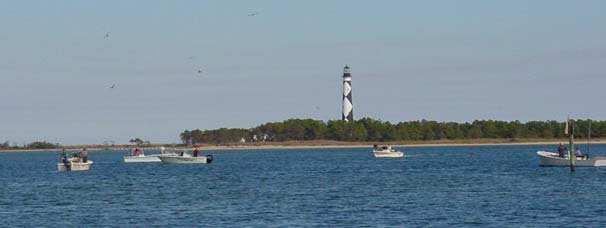
Home | Saltwater Flies | Fly Tying Materials | Saltwater Fly Fishing Accessories
Ordering Instructions, Shipping rates, Your Satisfaction Guaranteed

|
The false albacore fishing at Harker's Island, North Carolina is becoming legendary, and Jay Tinsky caught the hot action this fall. Here is his report. Every fall, around mid-October, a mad confluence of fish and fishermen occurs off a small island near Cape Lookout, North Carolina. Some seventy-five miles south of Cape Hatteras lies the sleepy little island known as Harker's Island. The town is known as a quiet commercial fishing village and vacation spot. But in the fall hundreds of anglers have discovered this fly fishing nirvana and travel both near and far to hear screaming reels and a chance to look far into their backing. Over the past several years this unlikely place has quickly become a Mecca for salt water fly rodders who target the annual migration of false albacore (little tunny) that inhabit the local waters. The blitzing false albacore or albies, have always migrated there, but it has been less than a decade since they have become a target of the flyrodder. And due to the unsavory nature of the meat of this species, the fly fishermen have the fish all to themselves. Tom Earnhardt, a noted author, fishing show host and fly fisherman has kept a home in the area for many years. Tom used to see the albacore crashing baits while on fishing trips for spotted sea trout. He tried to target the fish by using large deceivers to tempt the speedsters, yet the fish continually refused his offerings. After observing the albies chasing very small bait one day, Tom switched tactics and tied on a dace, a small freshwater trout pattern. He was soon tight to his first fly caught albie and a new fishery was born in lower North Carolina. Buzz Bryson another longtime NC fly fisher, fished with Tom in the early days and said that if they even saw one other boat with fly fishermen aboard they would jump up and go over and hug the other anglers. Then Tom invited Lefty Kreh to try his luck and the scene has grown exponentially larger with each coming year. 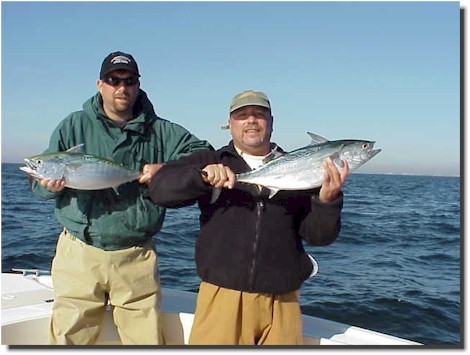
The island itself remains a quiet rustic place, devoid of large condos, hotels and boardwalks. The main fishing area lies from Cape Lookout down to Atlantic Beach including Beaufort (bow-fort) Inlet. The area is best covered by boat, which is a 15 minute scenic run from the island. Harker's actually sits just off mainland and is protected by a group of barrier islands. These barrier islands are desolate, wind blown sand dunes inhabited only by wild ponies. Ferries ($10) take wading anglers out to the hook area to chase breaking fish from shore. It is much more difficult to take the fish from the beach but the battle that ensues is much more rewarding. An albie hooked in shallow water will rip off more line and run farther than any boat hooked fish. The fall blitz generally runs from October to January with the best fishing being between late October to mid November. The length of the season varies with the weather and water temperatures. Albies prefer water temperatures in the mid sixties. Like any saltwater fishing destination, the quality of the fishing can be weather dependent. The wind is always a concern and a trip planned a year in advance can easy be washed out by a storm which can dirty the water and break up the schools of bait. There are many guides who migrate with the fish to take up residence at the island during the fall blitz. Prices range, but are similar to a Florida Keys flats guide. You can hear the guides on the radio helping each other to locate the best area to fish each day. When planning a trip you need to give yourself enough lead-time to book a room at Harker's. Sometimes it can take up to a year to get motel reservations for the prime weeks of the year. The two most popular motels start to book after March 1st. They offer humble accommodations with reasonable prices. Motel lodging 30-40 minutes away can be much easier to attain with short notice and some anglers have taken advantage of large breaks in the weather to schedule a quick trip. There are more accommodations in Beaufort, Morehead City, and Atlantic Beach than on Harkers itself. They're more modern, and actually can be cheaper. Also, for groups, there are lots of B&Bs and condos for rent, and that's during the off season. Finally, for those staying there, there are free state boat ramps in Morehead City and Beaufort, and it's just a few minutes run out to Beaufort Inlet. 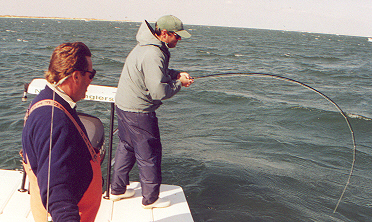
There are three main methods of fly fishing when using a boat. The first and most exciting method is to drive the boat near breaking fish and cast directly in front of the school. Make your cast in front of the pod, let the fly settle, and do not retrieve it too fast. Vary your retrieve - sometimes a twitch is all it takes. When several boats are on a breaking pod of fish, make sure one person is controlling the boat. Watch for other boats and make sure that the captain positions the boat so that back casts do not jeopardize other anglers. Also, as a safety precaution, debarb your flies! The second method is to mark fish on the meter, usually in 40-50 feet of water and chum them up with glass minnows. It is key to keep a small amount of bait in the water in order to create a slick. On slow days you may see a large group of boats slowly drifting while chumming up the fish. The key here is to dead drift a small white type Clouser Minnow with no flash drifting along with the boat in the slick. And hang on! The take is like hooking on to a passing car doing 30 mph. Fish in the slick seem to run larger and fish in the 15-20 pound range are not uncommon. The third method is to chase down the shrimp boats (draggers) that frequent the area. When the draggers, known locally as Bubba Gump, pull their nets, they throw back the bycatch which includes small baitfish, crabs, and a whole host of other small prey items. Albacore trail the boats waiting for a free meal. Anglers race up behind the boats and throw sinking lines into the fray. A dead drift twitch retrieve is effective here. Watch out for other anglers and the dragger's steel cables as they pull in their nets. 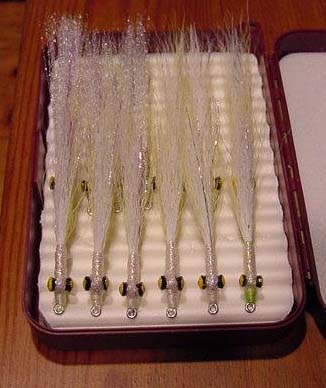
The bait in the local waters can vary greatly from year to year. A good bet is to use small flies that imitate glass minnows or bay anchovies. This year we also saw large silversides (5-7 inches), large shrimp, and peanut bunker. Watch what the fish are chasing and regurgitating when caught. Match the hatch. Clousers, Bob Popovic's jiggy flies and small candies work well. Blue and white, chartreuse and white, silver and white and light brown and white are common color combinations. Most anglers use 9 or 10 weight rods, but an 11 weight rod, though a little tougher to throw, comes in handy. Intermediate and sinking lines are the most widely used but don't hesitate to throw small poppers or crease flies to breaking fish using floating lines. Make sure you bring along extra lines, rods and reels. I've seen many rods broken and lines lost to wrapped lines, bad knots and propellers. A quality saltwater reel with a good drag is a must. These fish are strong and will fry out the cheaper models quickly. Noted albie angler Buzz Bryson listed 5 of the most common mistakes when fly fishing for albies: 1. Try not to race up to a pod of breaking fish. You end up either running over the fish or putting them down, which will anger other people fishing the same area and spoil your own chances at the fish. Careful boat handling will keep the fish up, and if your boat hooks up, other anglers can still ease up and cast at the same school. Many times the fishing will degenerate to a race to breaking fish, and this is socially unacceptable. 2. The biggest presentation problem is not adjusting retrieve rate to boat movement. You're constantly shifting locations and angles, and you have to constantly adjust retrieve to match boat drift, etc. Too often, people strip flies at a constant rate. When they cast with the wind, the boat will be drifting toward the fly, and a "normal" retrieve might not even keep the line tight. I've seen people over and over make a 60 foot cast, strip in line, but never move the fly! 3. OK, another "biggest" problem is too much false casting. This is not accuracy fishing, but the chances of scoring are greatly increased by keeping the fly in the water. Practice until you can cast 60-80 feet with only a couple of false casts. A lot of guys who fish albies here at Harker's over-line their rods, simply to load the rod more quickly for those 80 foot casts. One line weight over isn't going to overload any modern 9 or 10-weight rod, but it will help load it more quickly. This varies greatly with the rod and caster's style. 4. A word regarding fish fighting. People need to use heavy tippet, and learn how much pressure they can put on that heavy tippet. Too many people have no idea how much pressure they can put on a 12-20 lb tippet, when fighting a fish. Someone will break off a fish by clamping down on the reel against a running fish, popping the tippet. And that will break a leader in a heartbeat. But if they learn to not try and stop that first run, then apply pressure smoothly and firmly, and fight the fish off the butt of the rod, they could greatly reduce their fighting time and have a better chance at releasing a fish that will revive faster. 5. Finally, most rods are broken at boatside, by high-sticking when the fish is 20 feet away. Don't hold your rod too high; let your boat partner land your fish, and you'll keep from adding an extra piece to your rod! 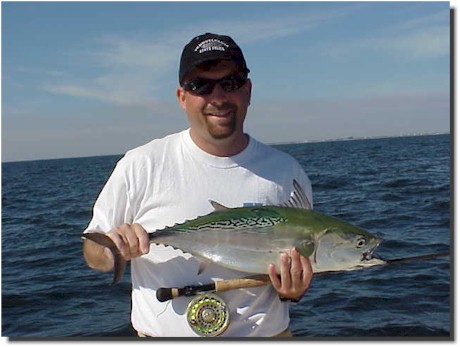
Harker's can be reached by plane or car. National carriers fly into New Bern, an hour's drive from the Island. Boat rentals are available but most people trailer their own boats. The cost for lodging and food is relatively inexpensive. The people on the island are friendly and generally happy to have your business during the off season. Nightlife on the island is non-existent, however there are several small restaurants located close by and some very good restaurants can be found in Beaufort. There are several gift shops on the island where one can purchase small gifts for loved ones back home. Tom Earnhardt and family host an annual pig roast and party during the first week in November. Tom is an extremely generous man and his party can have up to have over 200 fly fishers in attendance. All fly fishers visiting the area are frequently invited, and the guest list reads like a who's who of top nationally known fly fishers. False albacore can be found up and down the coast of North Carolina, including at Wrightsville Beach in Wilmington. Though the concentration of anglers is in the Cape Lookout area, it doesn't have to be! The fish range all over the coast, and can be caught in many other areas in coastal North Carolina. Cape Lookout gets all the ink and remains an excellent fishery for false albacore, and though it can be very crowded on the water it is a great fly fishing destination. If you like screaming reels and hard fought battles, this is the place for you. For lodging and more info: Calico Jacks Motel and Marina 252/728-3575 https://www.nps.gov/calo/ https://www.kbrcomm.com/trout/cryscoast.html Saltwaterflies.com would like to thank Jay Tinsky for his excellent contribution. Thanks to the efforts of folks like Jay, we can all learn something new that will help to make each day on the water more enjoyable. False Albacore Fever - Fly Fishing Photographs 2000
Want to learn more about false albacore fishing? These websites can offer more information on fishing spots, timing, and techniques: 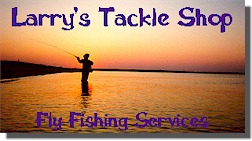
Larry's Tackle Shop TIGHT LINES! SaltwaterFlies.com - Got Backing? |
E-mail us with tales of your own at cwindram@SaltwaterFlies.Com!